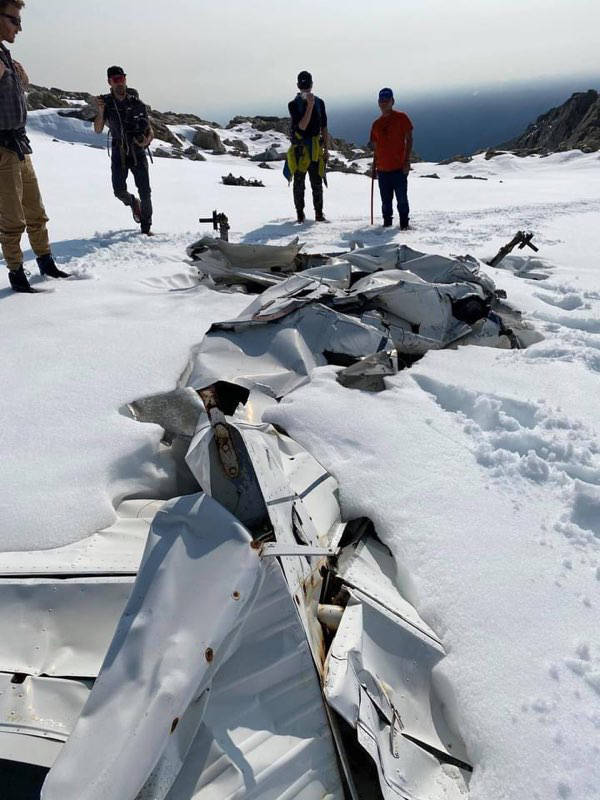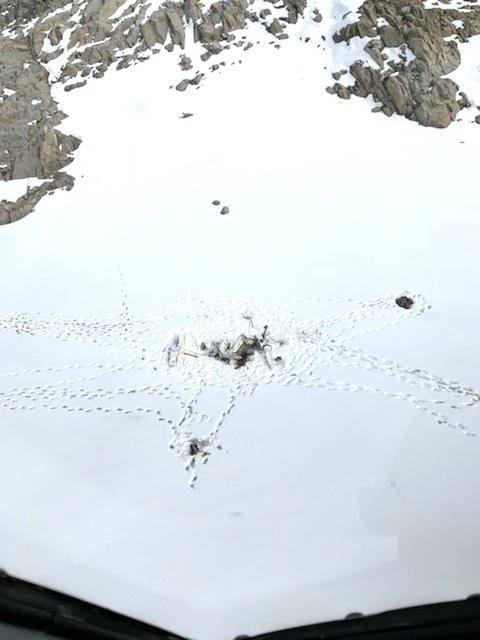There is precious little information available about an airplane crash in the Fraser Valley in April of 1957, but a melting ice field on a mountain towering above Harrison Lake may have revealed the 63 year old wreckage of Walter Dalton’s aircraft.
Dalton, a Vancouver real-estate executive, had two passengers on board on April 24, 1957 including radio personality and CBC reporter Fred McDowell.
He was flying from Penticton to Vancouver when his plane went down in an area that was noted for claiming aircraft. Over four months in that year alone, three planes were lost and nine people died within 15 miles of each other in the Hope-Princeton corridor.
With today’s airplane technology, it is relatively safe for a knowledgeable pilot to navigate over and through the wind-whipped peaks of the Cascade mountain range, but in Dalton’s day it was regarded as treacherous territory, described by some as the ‘graveyard of lost planes.’
Some wrecks and bodies were recovered. Many were not, with rescue/recovery crews thwarted by dense forested terrain and dangerous flying conditions.
Dalton’s plane was covered by ice and snow at 7000 feet elevation and there it stayed, defying discovery for more than six decades.
One day recently, John Faulkner of Chilliwack’s Librico Helicopters provided a ride for a team of Sts-ailes Community School students, accompanied by an archaeologist and a UBC geo-scientist, dropping them off near the glacier field.
“We were on an archaeological trip in traditional Chehalis territory that has a lot of artifacts and historical/cultural significance,” said the expedition leader Adam Palmer, a mountain skills teacher at Sts’ailes Community School. “As we were moving from one location to another, I saw something in the distance that looked like plane wreckage.
“As we start walking towards it, we saw this tangled mess of aircraft in the ice.”
Palmer has been up there many, many times and not seen the wreckage, but on this trip the timing was perfect.
“The snow level is at the lowest point it’ll be all year,” he said. “When we got closer we could see that, over time, it’s embedded in the ice. Over the years, the sun hitting the wreckage at certain times of the year has been heating it and causing it to melt further into the ice. Then it re-solidifies in the colder months.
“And because a glacier is a river of ice flowing down, it’s been stretching and pulling and twisting it within the ice, to the point where the glacier and the aircraft have kind of become one.”
The sight, Palmer said, was an eerie one for many reasons.
Who knows how many times he’s walked right over top of the airplane during his expeditions, never suspecting it was there.
“We’re on this archaeological expedition looking for ancient artifacts, and everyone was more interested in trying to dig to the bottom of the aircraft to see if there were remains of any survivors,” Palmer said. “Your automatic response when you see something like that is, ‘What happened?’ It’s human nature that you want to know.”
When Faulkner and his helicopter returned three days later, Palmer’s crew told him about the wreckage. They snapped plenty of pics and video on the ground, and Faulkner took more photos from the air as they flew over the site.
When he got back, he told Blair Edlund.
Edlund operates an airplane repair business (EA Structures Ltd.) at the Chilliwack airport, and the story piqued his interest.
“Luckily enough, the registration on the airplane tail was still there, as clear as day,” Edlund recalled.
Faulkner thought the wreckage looked ‘fairly fresh,’ but when Edlund tried looking up the registration in the Transport Canada database he got no hit.
“So either this plane was really old or it was not registered for some nefarious reason,” he surmised.
Shifting into ‘amateur sleuth’ mode, Edlund started digging.
The only reference he could find to an airplane crash in that area came from a MacLeans article published in January of 1958, appropriately titled ‘The Toughest Flying Country in the World.’
It references an airplane going down in the region.
While he can’t be 100 per cent certain this airplane is that airplane, it’s a very strong guess.
“Transport Canada’s digital archive only goes back to the late 1980s, so the MacLeans article was how I determined that yes, it was a recorded crash and there was loss of life,” Edlund said. “I spent hours trying to get this info.
“A lot of these crashes from way back when, they never get resolved. They just get frozen in time.”
This wreckage may get frozen once more as winter sets in and the glacier swallows it up.
“I don’t know what will happen with it,” Edlund said. “Typically, if it’s able to be removed it’s removed, but for all the time it’s been sitting up there, maybe they’ll just leave it.
“It’s probably only visible for two to four weeks out of the year, so it might be a while before anyone sees it again.”
eric.welsh@theprogress.com
Like us on and follow us on .
Want to support local journalism during the pandemic? Make a donation




